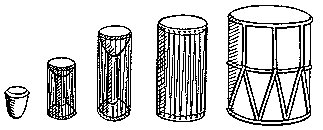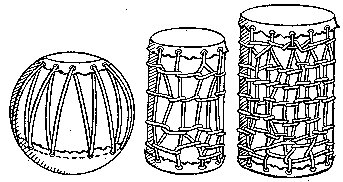|
TRANSLATIONS
Next pages:
There is a complex problem here. Saturn is the 7th ancestor, the clever one who rules Jupiter and through him the rest of them. So much we learned from Hamlet's Mill, and the Polynesians thought he was the ruler too: ... Fetu-tea [Pale Star = Saturn] was the king. He took to wife the dome of the sky, Te-Tapoi-o-te-ra'i, and begat stars that shine (hitihiti) and obscure, the host of twinkling stars, fetu-amoamo, and the phosphorescent stars, te fetu-pura-noa. There followed the star-fishes, Maa-atai, and two trigger-fishes that eat mist and dwell in vacant spots in the Milky Way, the Vai-ora or Living-water of Tane. The handsome shark Fa'a-rava-i-te-ra'i, Sky-shade, is there in his pool and close by is Pirae-tea, White Sea-swallow (Deneb in Cygnus) in the Living-waters of Tane ... Tane presumably was the Milky Way, and the stem of this great tree possibly served as an explanation of what happened when the sky dome in spring was raised higher and higher. Spring sun and Tane therefore should be closely connected. Saturn sat at the bottom, presumably like a big black fish at Te Pei, and from there his executive fetched the orders. Maybe it was Sirius, maybe it was Jupiter. The black moon seems to have had Mercury as executive. On New Zeland Mercury was Whiro:
The thief close to the sun is exactly right for the first appearance of new moon after she has dipped into the vaiora a Tane. Mercury is the planet immediately before Jupiter, close to him. Jupiter serves as a planet ruler closer to the sun than Saturn. He is also king, but only a lesser one. Mercury is close both to the sun and to Jupiter, a sneaky spineless character who is using trickery instead of force. Odin rules Wednesday, he is Mercury. Trickery is his trade, not force, however much he tries with his illusions to make us believe different. In a way he represents the 2nd Word. By logic everything can be twisted and turned into its opposite. He is indeed no man, Noman like Odysseus. When the forest had to go, you needed great convincing power. The ruler in Iron Age must be clever indeed. The chief executive of the great enterprise is Mercury. He is also the planet (the ruler) of merchant man. The clever no man is the creative genius emerging from the black hole. The man who tricks the others into action by his magic skills. He creates so much change at once that it feels like an earth-quake. But he does not rule, he takes his measures from the board. The problem I perceive is that there were 8 drums of different sizes, according to Ogotemmêli: "The most important of all drums, he said, was the armpit drum. The Nummo made it. It consists of two hemispherical wooden cups connected through their centres by a slender cylinder. It is like an hour-glass with a very long narrow neck. With this instrument tucked between his left arm and armpit, the drummer, by pressing on the hollow structure of thin wood, can tighten or relax the tension on the skins and so modify the tone. 'The Nummo made it. He made a picture of it with is fingers, as children do today in games with string.' Holding his hands apart, he passed a thread ten times round each of the four fingers, but not the thumb. He thus had forty loops on each hand, making eighty threads in all, which, he pointed out, was also the number of teeth of his jaws. The palms of his hands represented the skins of the drum, and thus to play on the drum was, symbolically, to play on the hands of the Nummo. But what do they represent? Cupping his two hands behind his ears, Ogotemmêli explained that the spirit had no external ears but only auditory holes. 'His hands serve for ears,' he said; 'to enable him to hear he always holds them on each side of his head. To tap the drum is to tap the Nummo's palms, to tap, that is, his ears.' Holding before him the web of threads which represented a weft, the Spirit with his tongue interlaced them with a kind of endless chain made of a thin strip of copper. He coiled this in a spiral of eighty turns, and throughout the process he spoke as he had done when teaching the art of weaving. But what he said was new. It was the third Word, which he was revealing to men." "Each drum had a sound of its own, and so each family had its own language, which is the reason why there are different languages today. The first two families, settled in the south, spoke two dialects of Toro, not very different from each other; the third family spoke Mendéli; the fourth spoke Sanga; the fifth another form of Toro; the sixth Bamba; and the seventh Iréli. Lastly the eighth family was given a language which is understood in all parts of the cliff. Just as the eighth drum dominates all the others, so the eighth language is understood everywhere.
It was thus that men were given the third Word, final, complete and multiform to suit the new age. It was closely associated, like the first and second Words, and even more than they, with material objects. At this point an odd reflection occured to the European. The first imperfect Word was associated with a technical process, simple in character and no doubt the most archaic of all processes, which had produced the most primitive form of clothing made of fibre. The fibre, which was neither knotted nor woven, flowed in a wavy line, and might be said therefore to be of one dimension. The second Word, less restricted than the first, arose from weaving, done on a wide warp crossed by vertical threads forming a surface, that is to say, having two dimensions. The third Word, clear and perfect in character, took shape in a cylinder with a strip of copper winding through it, that is to say, in a three-dimensional figure. These three technical processes (as he further remarked) all proceeded by following a line, either undulating or zig-zag, and each was characterized by three distinct features: humidity of the fibres, ensuring the freshness necessary for procreation; light for the weaving, that being a daylight process, prohibited at night on pain of blindness; sonority of the drum. There was also a development, from the material point of view, from trimmed bark to cotton thread, and from thread to leather strips and to a copper band." "The European had known for years the magical function of the sounds of a smithy. He had been present many times at rituals in the course of which at a certain point a smith would strike the rock with his hammer or with the iron part of his anvil. By producing sound from the iron, in which the mythical first smith had brought so many benefits to mankind, he was reminding his fellow-men of the supreme power of Amma and the Water Spirit. He was assisting their prayers and strengthening them by the sounds he made; he was appeasing the possible wrath of the celestial Beings by this acknowledgement of their pre-eminence. When men quarrelled with one another, he would intervene between the parties, hammer in hand, and strike the rocks, thus bringing a divine note into the human disorder and calming the passions aroused ..." The hammer identified the ruler down on earth who kept order among all the different peoples. It is the Thursday sign. It is Jupiter, not Mercury. But the biggest drum is the 8th. Who owns the 8th drum? The 6th drum, the round one, should be the drum of Mercury (never being still). The 7th drum must be the drum of Jupiter, then. The armpit drum, like a hour-glass, must be the moon, the ruler of time. There are two such drums among the 8, presumably one for waxing and one for waning moon. The little drum at left could be the infant sun, which is taken care of by the moon. Then comes a stage when sun is like Mars, who has two faces - two drums. Next he is not old enough to become Jupiter, but he has to keep close to him, to listen carefully, and to run quickly. Only by doing so and being very clever can he survive to next stage in the hierarchy. |

